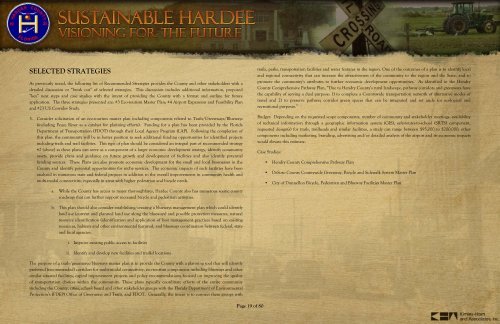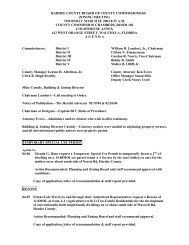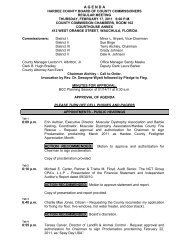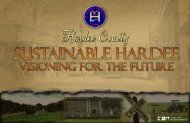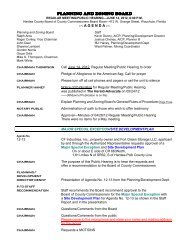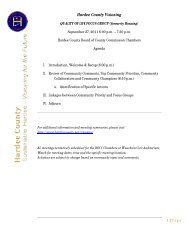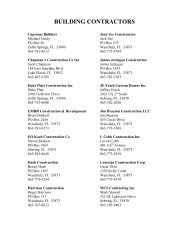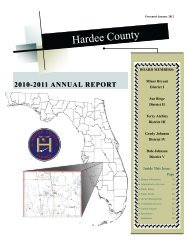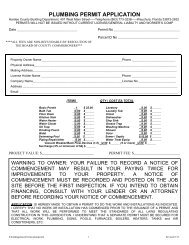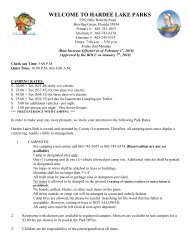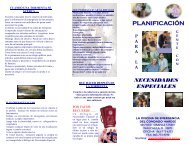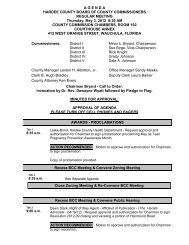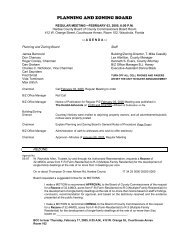FINAL Document 1/23/2013 - Hardee County
FINAL Document 1/23/2013 - Hardee County
FINAL Document 1/23/2013 - Hardee County
Create successful ePaper yourself
Turn your PDF publications into a flip-book with our unique Google optimized e-Paper software.
SELECTED STRATEGIES<br />
As previously noted, the following list of Recommended Strategies provides the <strong>County</strong> and other stakeholders with a<br />
detailed discussion or “break out” of selected strategies. This discussion includes additional information, proposed<br />
“key” next steps and case studies with the intent of providing the <strong>County</strong> with a format and outline for future<br />
application. The three strategies presented are: #3 Eco-tourism Master Plan; #4 Airport Expansion and Feasibility Plan<br />
and #<strong>23</strong> US Corridor Study.<br />
3. Consider solicitation of an eco-tourism master plan including components related to Trails/Greenways/Blueways<br />
(including Peace River as a catalyst for planning efforts). Funding for a plan has been provided by the Florida<br />
Department of Transportation (FDOT) through their Local Agency Program (LAP). Following the completion of<br />
this plan, the community will be in better position to seek additional funding opportunities for identified projects<br />
including trails and trail facilities. This type of plan should be considered an integral part of recommended strategy<br />
#2 (above) as these plans can serve as a component of a larger economic development strategy, identify community<br />
assets, provide plans and guidance on future growth and development of facilities and also identify potential<br />
funding sources. These Plans can also promote economic development for the small and local businesses in the<br />
<strong>County</strong> and identify potential opportunities for niche services. The economic impacts of such facilities have been<br />
analyzed in numerous state and federal projects in addition to the overall improvements in community health and<br />
multi-modal connectivity, especially in areas with higher pedestrian and bicycle needs.<br />
a. While the <strong>County</strong> has access to major thoroughfares, <strong>Hardee</strong> <strong>County</strong> also has numerous scenic county<br />
roadways that can further support increased bicycle and pedestrian activities.<br />
trails, parks, transportation facilities and water features in the region. One of the outcomes of a plan is to identify local<br />
and regional connectivity that can increase the attractiveness of the community to the region and the State, and to<br />
promote the community’s attributes to further economic development opportunities. As identified in the Hendry<br />
<strong>County</strong> Comprehensive Pathway Plan, “Due to Hendry <strong>County</strong>’s rural landscape, pathway corridors and greenways have<br />
the capability of serving a dual purpose: 1) to complete a <strong>County</strong>wide transportation network of alternative modes of<br />
travel and 2) to preserve pathway corridor green spaces that can be integrated and set aside for ecological and<br />
recreational purposes.”<br />
Budget: Depending on the requested scope components, number of community and stakeholder meetings, availability<br />
of technical information through a geographic information system (GIS), safe-routes-to-school (SRTS) component,<br />
requested design(s) for trails, trailheads and similar facilities, a study can range between $95,000 to $200,000; other<br />
components including marketing, branding, advertising and/or detailed analysis of the airport and its economic impacts<br />
would elevate this estimate.<br />
Case Studies:<br />
• Hendry <strong>County</strong> Comprehensive Pathway Plan<br />
• DeSoto <strong>County</strong> <strong>County</strong>wide Greenway, Bicycle and Sidewalk System Master Plan<br />
• City of Dunnellon Bicycle, Pedestrian and Blueway Facilities Master Plan<br />
b. This plan should also consider establishing/creating a blueways management plan which could identify<br />
land use (current and planned land use along the blueways) and possible protection measures, natural<br />
resource identification (identification and application of best management practices based on existing<br />
resources, habitats and other environmental features), and blueways coordination between federal, state<br />
and local agencies.<br />
i. Improve existing public access to facilities<br />
ii. Identify and develop new facilities and trail(s) locations<br />
The purpose of a trails/greenways/blueways master plan is to provide the <strong>County</strong> with a planning tool that will identify<br />
preferred (recommended) corridors for multi-modal connectivity, eco-tourism components including blueways and other<br />
similar situated facilities, capital improvement projects and policy recommendations focused on improving the quality<br />
of transportation choices within the community. These plans typically coordinate efforts of the entire community<br />
including the <strong>County</strong>, cities, school board and other stakeholder groups with the Florida Department of Environmental<br />
Protection’s (FDEP) Office of Greenways and Trails, and FDOT. Generally, the intent is to connect these groups with<br />
Page 19 of 80


